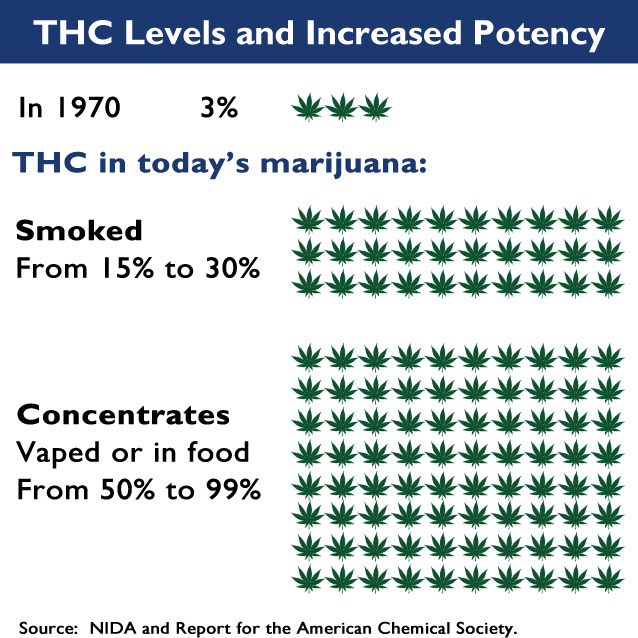Facts & Risks
Educate Your Family on Dangers of Marijuana Use
Marijuana use comes with real risks that can impact a person’s health and life.
Whether marijuana is smoked, vaped, or eaten, there are adverse effects associated with use in any form.
Studies have found marijuana is an addictive, harmful, and mind altering drug. It over-activates parts of the brain and negatively affects brain development. Marijuana leads to physical health problems, mental health problems, and risk of addiction.
With the legalization of medical and recreational marijuana throughout the United States, marijuana potency has increased exponentially. Concentrates are not the traditional joint of the past. Concentrates are highly potent, THC-rich forms of marijuana that can be vaped, dabbed, and used in edibles.
Exposure to high levels of THC, the chemical in marijuana that causes impairment, increases the risks of physical dependence and addiction. Higher doses of THC are more likely to produce anxiety, agitation, paranoia, and psychosis.
Arizona Parents: Do you need tips on how to talk to your child about the new recreational marijuana laws? Download these talking tips today.

Surgeon General Advisory
– VADM Jerome Adams, the first Surgeon General Advisory on marijuana since 1982

%
Almost 30% of teens have used marijuana - this is TOO many!
Latest Studies
State Cannabis Legalization and Trends in Cannabis-Related Disorders in US Older Adults, 2017 to 2022 | JAMA | 6/18/2024
An increasing number of US states and territories have enacted laws allowing adult and/or medical use of marijuana (cannabis).1 As expanded access coincides with increased prevalence of medical and nonmedical cannabis use,2 we characterized trends in health care encounters with cannabis-related disorders among Medicare beneficiaries aged 65 years or older by state or territory cannabis legal status.
Heavy Lifetime Cannabis Use and Mortality by Sex | JAMA | 6/8/2024
Key Points
Question Is there an association between cannabis use and all-cause, cardiovascular disease (CVD), and cancer mortality?
Findings In this cohort study of 121 895 participants, in the fully adjusted model among females, the risk for CVD mortality was significantly higher among heavy cannabis users compared with never users; there was no association among males. No association was observed among females or males for all-cause and cancer mortality.
Meaning The findings suggest that heavy cannabis use is associated with CVD mortality among females.
Incident psychotic experiences following self-reported use of high-potency cannabis: Results from a longitudinal cohort study | Wiley Online Library | 5/13/2024
Background and aims
High-potency cannabis has been associated with increased risk of psychosis, but a lack of prospective data hinders understanding of causality in this relationship. This study aimed to combine prospective report of cannabis use with retrospective report of potency to infer the potency of cannabis used in adolescence and explore whether use of cannabis, and the use of high-potency cannabis, in adolescence is associated with incident psychotic experiences.
Associations of cannabis use, use frequency, and cannabis use disorder with violent behavior among young adults in the United States | PubMed | 4/26/2024
Abstract
Background: Most violent crimes (52 %) are committed by adults aged 18-34, who account for 23 % of the US population and have the highest prevalence of cannabis use and cannabis use disorder (CUD). We examined whether and how associations of cannabis use, use frequency, and CUD with violent behavior (i.e., attacking someone with the intent to harm seriously) vary by sex in U.S. young adults.
Methods: Data were from 113,454 participants aged 18-34 in the 2015-2019 US National Surveys on Drug Use and Health, providing nationally representative data on cannabis use, CUD (using DSM-IV criteria), and violent behavior. Descriptive analyses and bivariate and multivariable logistic regression analyses were conducted.
The prevalence of cannabis use disorders in people who use medicinal cannabis: A systematic review and meta-analysis | PubMed | 4/1/2024
Abstract
Background: The prevalence of cannabis use disorders (CUDs) in people who use cannabis recreationally has been estimated at 22%, yet there is a dearth of literature exploring CUDs among people who use medicinal cannabis. We aimed to systematically review the prevalence of CUDs in people who use medicinal cannabis.
Methods: In our systematic review and meta-analysis, we followed PRISMA guidelines and searched three databases (PsychInfo, Embase and PubMed) to identify studies examining the prevalence of CUDs in people who use medicinal cannabis. Meta-analyses were calculated on the prevalence of CUDs. Prevalence estimates were pooled across different prevalence periods using the DSM-IV and DSM-5.
Latest NEWS Commentary
Weed Is Dangerous. Legalizing It Was a Mistake | The Free Press | 3/12/2024
For years, cannabis advocates claimed that legalizing recreational marijuana would benefit America. But more than a decade into the experiment, it’s clear that legalization has been nothing short of a disaster.
